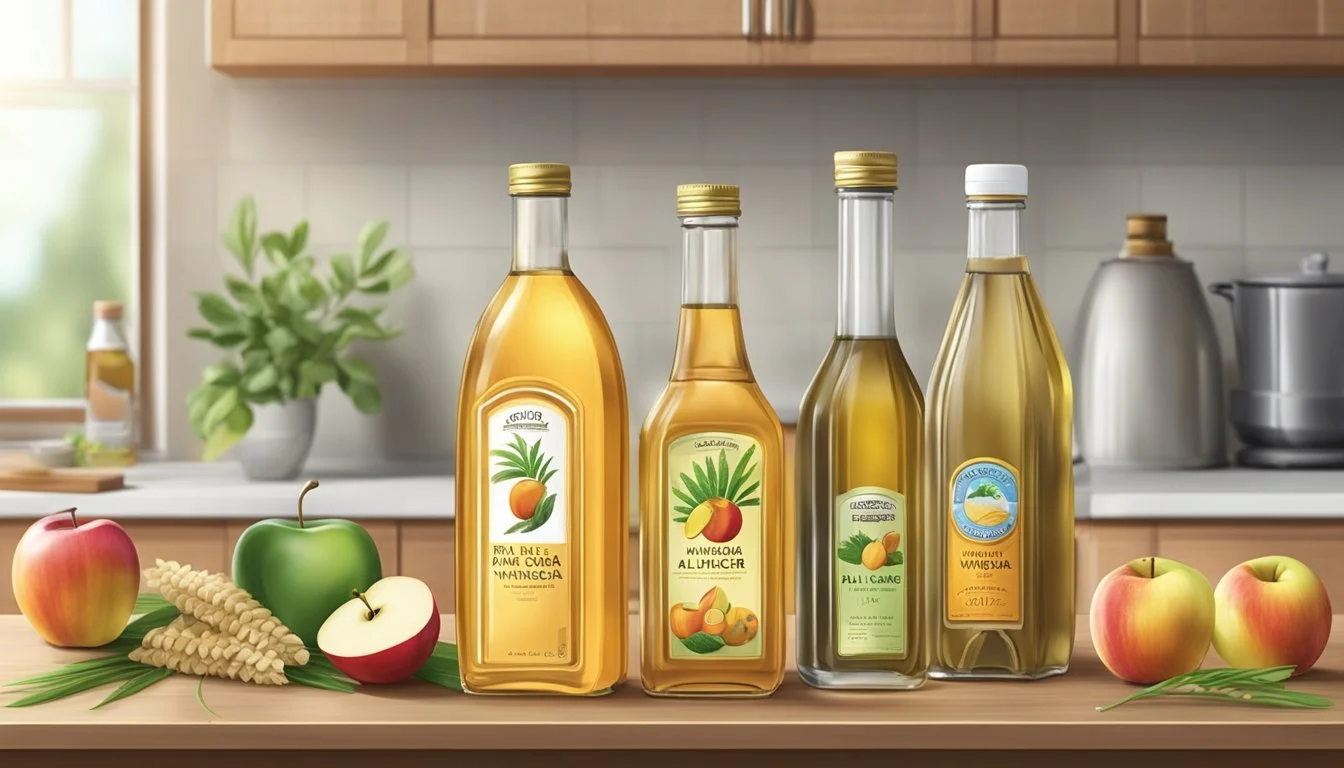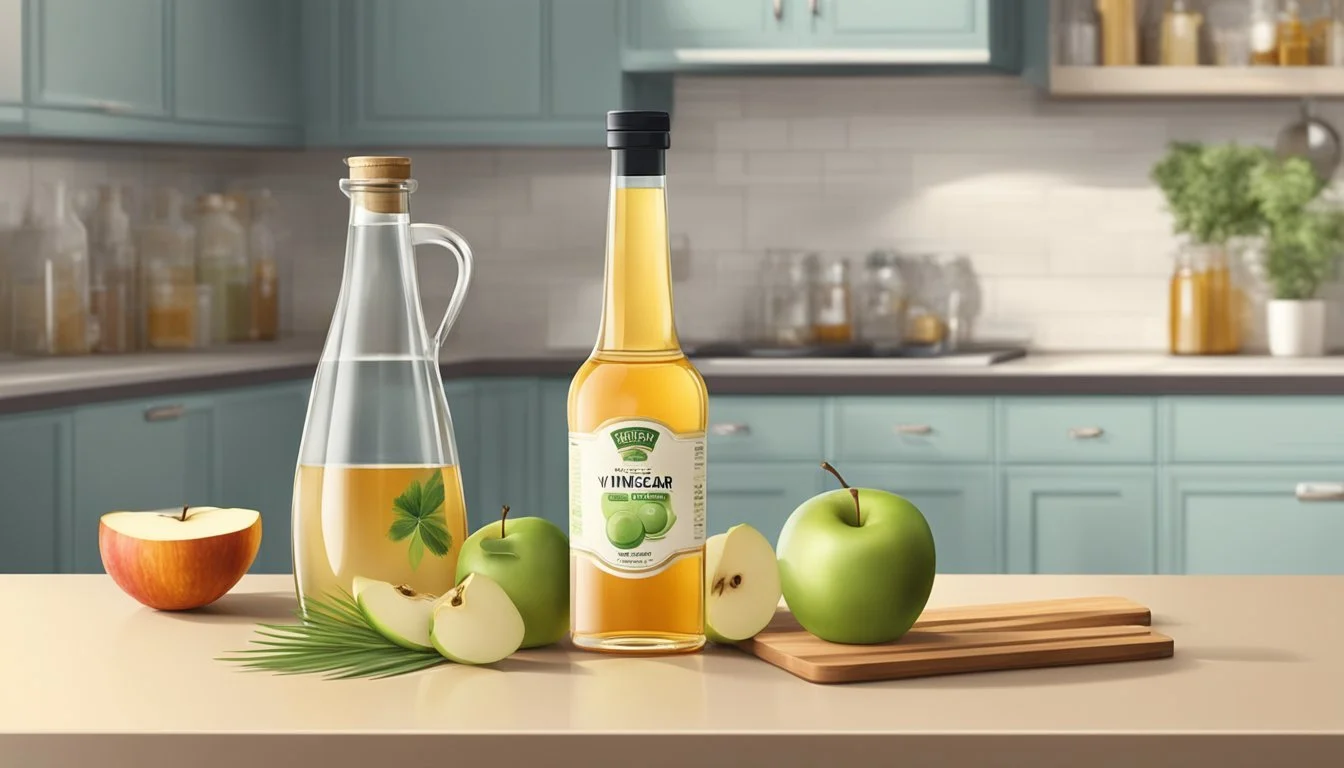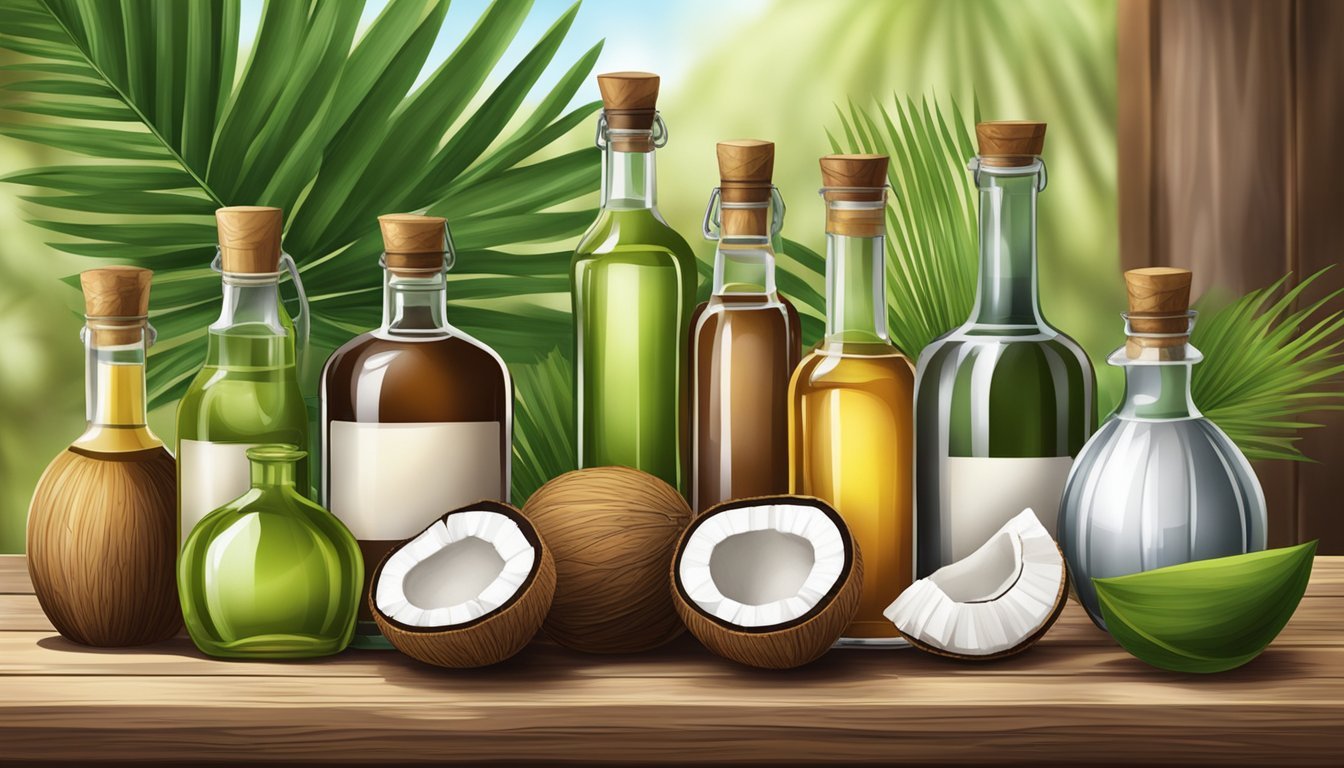Palm Vinegar Substitutes
Top Alternatives for Your Cooking Needs
Palm vinegar, crafted from the fermented sap of various palm trees, is a staple ingredient in many Asian cuisines, notably in the Philippines where it is known for its robust flavor profile. It possesses a distinctive musty taste and cloudy appearance, owing to its natural fermentation process. Palm vinegar is versatile in cooking, often used to add a bright acidity to marinades, dressings, and sauces. However, it might not always be readily available to everyone due to geographical or supply reasons.
When palm vinegar is not an option, cooks can consider several effective substitutes without compromising on flavor in their recipes. Suitable alternatives include rice wine vinegar mixed with lime juice, apple cider vinegar with a touch of sugar, or white wine vinegar paired with lime zest. Each of these substitutes offers a unique spin on the tartness and depth that palm vinegar brings to dishes, and they are readily available in many kitchens or local stores.
Selecting the right vinegar substitute depends on the desired outcome in taste and the recipe's needs. Rice wine vinegar and lime juice closely mimic palm vinegar's fruitiness and acidity, making it a great selection for dishes that require a delicate balance of flavors. Apple cider vinegar, with its subtle apple undertone, brings a mild and versatile profile suitable for a variety of culinary applications. White wine vinegar, with an addition of lime zest, offers a zestier punch. These alternatives ensure that dishes retain their intended flavor profiles even in the absence of palm vinegar.
Understanding Vinegars and Their Uses
Vinegar stands out in the culinary world for its versatility in cooking, as a condiment, and for its varied health benefits. Each type of vinegar brings a unique flavor profile and set of uses to the table, serving as a key ingredient in everything from salad dressings to pickles.
Types of Vinegar
Distilled White Vinegar: Known for its clear appearance and sharp acidity, it is frequently used for pickling and cleaning.
Apple Cider Vinegar: Made from fermented apple cider, it offers a milder taste with a subtle apple flavor, suitable for vinaigrettes and sauces.
Balsamic Vinegar: A dark, concentrated and intensely flavorful vinegar, often used in salad dressings and to add depth to sauces.
Rice Wine Vinegar: With a gentle acidity, it is a staple in Asian cuisine, particularly for sushi rice and marinades.
Red and White Wine Vinegar: These are fermented from wine and have a sharp, tangy taste perfect for marinades and salad dressings.
Culinary Roles of Vinegar
Flavor Enhancer: Vinegars add zest to dressings, marinades, and sauces, elevating the overall taste of the dish.
Preservative: The acidic nature of vinegar makes it ideal for pickling, helping to preserve fruits and vegetables.
Tenderizer: It contains enzymes that help to break down proteins, making it an effective meat tenderizer.
Leavening Agent: In baking, when combined with baking soda, it acts as a leavening agent, contributing to the rise of baked goods.
Health and Nutritional Aspects
Digestive Health: Some vinegars, like apple cider vinegar, are believed to have probiotic effects and can aid in digestion.
Blood Sugar Control: Vinegar may help to regulate blood sugar levels, though one should not rely on it as a sole treatment for diabetes.
Low Calories: Vinegar is low in calories and can add flavor without adding a significant number of calories, making it a desirable ingredient for weight management.
Primary Substitutes for Palm Vinegar
When seeking alternatives for palm vinegar, one should consider substitutes that offer a similar tanginess and fermentation profile. Below are some viable options.
Coconut Vinegar
Coconut vinegar is produced from the sap of the coconut tree and bears a resemblance to palm vinegar in terms of flavor and cloudiness. Like palm vinegar, coconut vinegar has a slightly musty flavor profile due to its fermentation process. It can serve as a straightforward 1:1 substitute in most recipes, offering a comparable level of acidity and fruitiness.
Cane Vinegar
Another option is cane vinegar, derived from sugarcane juice. This vinegar substitute presents a mild taste and is less acidic compared to palm vinegar, but still maintains a similar sweetness. Its subtle flavors are suitable for dressings, marinades, and sauces where it can replace palm vinegar without overpowering the dish.
Apple Cider Vinegar
Apple cider vinegar is a versatile vinegar substitute that can be sweetened to mimic palm vinegar’s characteristic flavor. While naturally more robust, adding a pinch of sugar can balance its profile. It's a widely available substitute and can work quite well in various dishes, from dressings to marinades.
List of Substitutes:
Coconut Vinegar: Similar tanginess, perfect for a 1:1 substitution.
Cane Vinegar: Mild taste; may require adjusting quantities to match desired sweetness.
Apple Cider Vinegar: Robust flavor; modify with sugar for closer palm vinegar approximation.
Other Vinegar Alternatives
When exploring alternatives to palm vinegar, one can consider various vinegars from different origins and base ingredients, each offering unique flavor profiles suitable for specific culinary applications.
Rice Vinegar Variants
Rice vinegar, particularly popular in Asian cuisine, has a mild, slightly sweet flavor. Two notable types are:
White rice vinegar: A go-to for sushi rice and salad dressings.
Brown rice vinegar: Richer and often used to enhance the depth of stews and sauces.
Fruit-Based Vinegars
Fruit-based vinegars offer a broad spectrum of flavors, from the subtle to the robust. They include:
Apple cider vinegar: Coupled with sugar, it can be a versatile substitute for palm vinegar.
Balsamic vinegar: Adds a distinct sweetness perfect for dressings and reductions.
Wine Vinegar Options
Wine vinegars are known for their sharpness and authenticity in European dishes. Some examples are:
Red wine vinegar: Ideal for hearty stews and marinades.
White wine vinegar: Often used in lighter sauces and vinaigrettes.
Champagne vinegar: Delicate and suitable for subtle dressings.
Distilled White Vinegar
Although sharper, distilled white vinegar is a common pantry staple and can be a neutral substitute for palm vinegar if adjusted with a touch of sweetness. Use sparingly in dishes where a more robust flavored vinegar is not required.
Non-Vinegar Substitutes
When palm vinegar is not available, and a vinegar-free option is needed for recipes requiring its distinct flavor, there are several alternatives. They can impart the necessary acidity to complement the dish.
Citrus Juices
Lemon juice and lime juice are excellent substitutes for palm vinegar. They impart a bright, tangy flavor similar to the acidic notes in palm vinegar. For each tablespoon of palm vinegar, one can use:
1 tablespoon of lemon juice
1 tablespoon of lime juice
It's advisable to start with a smaller quantity and adjust to taste, as citrus juices can have varying levels of acidity.
Tamarind Paste
Tamarind paste offers a sour taste with a hint of sweetness that mirrors the complexity of palm vinegar. To replace palm vinegar in a recipe:
Dissolve 1/2 teaspoon of tamarind paste in 1 tablespoon of warm water.
This mixture can then be used in a 1:1 ratio as a substitute for palm vinegar, adding a depth of flavor especially suitable for Southeast Asian dishes.
Other Acidic Replacements
For recipes that require the sourness of palm vinegar, but where a non-vinegar substitute is desired, one might consider:
Citric acid, which is a powdered form of acidity that can be used judiciously. A very small amount goes a long way.
When using citrus fruits as a substitute, remember that the zest can also add a burst of flavor, though it lacks the liquid content of the juices.
Considering Acidity Levels and Flavor Profiles
When substituting palm vinegar, one must carefully match both the acidity and flavor profile to ensure the intended character of the dish remains intact.
Managing Sweetness and Tartness
To replicate palm vinegar's balanced sweet and tart nature, it's essential to consider both components in a substitute. A common approach involves mixing milder vinegars with natural sweeteners. For example:
Apple Cider Vinegar: With an acidity level typically ranging from 4 to 5%, apple cider vinegar's fruity notes can be balanced with a touch of sugar or honey to match palm vinegar's sweetness.
Rice Vinegar: Often milder and sweeter, rice vinegar may only require a small pinch of salt to bring out its tartness.
Sugar Adjustments: Start with small increments when adding sweeteners like sugar or honey — a half tablespoon per tablespoon of vinegar — and adjust based on the dish's requirements.
Herbs and Spices as Flavor Enhancers
Incorporating herbs and spices can compensate for flavor differences when substituting vinegar types. Herb vinegars, in particular, can bring a unique aromatic depth to a dish. Here are specific ways to use them effectively:
Infused Vinegars: Select an herb vinegar that complements the dish's primary flavors. For example, a basil-infused vinegar could add a Mediterranean twist.
Spice Combinations: When a touch of warm spice is necessary, consider a dash of cinnamon or clove to echo palm vinegar's complexity.
Herb Freshness: Fresh or dried herbs may also be added directly to the substituting vinegar to infuse additional flavor notes.
By focusing on these elements, one can successfully mimic the essence of palm vinegar, maintaining the intended flavor balance of the original recipe.
Creative Cooking with Vinegar Substitutes
When palm vinegar is unavailable, a cook's ingenuity can turn to other vinegar types to achieve the desired flavor and acidity in various dishes. The choice of substitute often depends on the dish being prepared and the role vinegar plays within it.
Recipes and Appropriateness
Different recipes call for specific vinegars due to their unique flavors and acidity levels. For instance:
Asian cuisines often incorporate rice wine vinegar mixed with a bit of lime juice to mimic palm vinegar's fruity acidity.
In Filipino dishes that typically use palm vinegar, a combination of apple cider vinegar and a pinch of sugar can provide a comparable sweetness and tang.
Adjustments in Salad Dressings and Marinades
Salad dressings and marinades require careful balance. Here are some specifics:
Salad dressings can substitute palm vinegar with a mix of white wine vinegar and lime zest for a burst of freshness.
For marinades where palm vinegar is a tenderizer, using apple cider vinegar maintains the meat-softening acids, and one can adjust the sweetness to taste.
Desserts and Sweets Innovations
The use of vinegar in desserts may seem unconventional, but it can enhance flavors and offer a counterbalance to sweetness.
A vinaigrette for fruit salads might typically use palm vinegar; however, a blend of lemon juice or white wine works well as a sweet yet tangy alternative.
When seeking a subtle piquancy in desserts, a splash of a mild vinegar like rice wine vinegar can be introduced without overpowering the sweet components.
Availability and Practical Considerations
When choosing a palm vinegar substitute, one must consider both its availability in the local market and the suitability for the intended culinary application. These considerations are often influenced by economic and geographic factors.
Pantry Essentials
Palm vinegar is commonly used in Filipino cuisine, making it a staple in many Filipino households. However, in areas outside the Philippines, it may not be readily available. Home cooks should consider common pantry items for substitutions. For example, rice wine vinegar mixed with lime juice can emulate palm vinegar's balance of acidity and tropical flavor without much hassle. Apple cider vinegar sweetened with sugar is also a notable substitute, offering a similar acidic profile with an additional hint of sweetness.
Typical substitutes found in the pantry:
Rice wine vinegar
Apple cider vinegar
White wine vinegar
Lime juice
Economic and Geographic Factors
The economic availability of palm vinegar is highly dependent on the geographic region. In the Philippines, where palm vinegar is produced and widely consumed, it is both economically and geographically accessible. However, in other regions, especially where it must be imported, alternatives may be more budget-friendly due to local production and lower transportation costs.
Key factors affecting availability:
Factor Influence on Availability Local production Higher availability and lower cost of local products Import costs Higher retail price and limited stock for imports
For geographic reasons, cane vinegar is suggested as a close alternative to palm vinegar. It is frequently found in international markets and thus remains accessible for a diverse audience. The regional context thus dictates the most practical and available substitutes.









